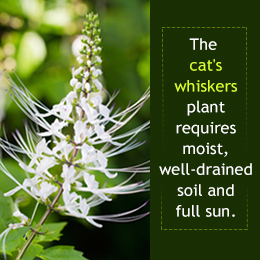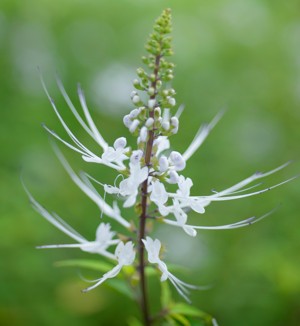One glance at the cat's whiskers plant will tell you why it is called so. Buzzle provides information on cat's whiskers plant care, including the ideal location, soil type, light, and watering requirements for this plant.

The cat's whiskers plant is not just an ornamental plant, it is known for its therapeutic properties in the regions of Southeast Asia. Java tea, which is an infusion made from the dried leaves of this plant, is often recommended by herbalists for the treatment of kidney stones.The cat's whiskers plant belongs to
Orthosiphon genus and
Lamiaceae family. Rather interesting to look at, this perennial flowering plant is known by different names. It is native to southern China, the Indian subcontinent, Southeast Asia, and the tropical regions of Queensland, Australia. It is known as
kumis kucing and
misai kucing in Indonesia and Malaysia, respectively. Its scientific name is
Orthosiphon aristatus.
The reason why this plant is called cat's whiskers is due to the whisker-like appearance of the long stamens extending past its petals. Its glossy, ovate leaves have serrated margins. Racemes of flowers can be seen at the end of branches. This plant has a shrubby habit, and is definitely an excellent addition to any garden. Its flowers are usually white in color, but you may come across varieties that produce mauve or purple flowers.Cat's Whiskers Plant Information

Cat's Whiskers Plant✦
Genus:
Orthosiphon
✦
Family:
Lamiaceae
✦
Scientific name:
Orthosiphon aristatus
✦
Also Called: Kumis kucing (Indonesia), Misai kucing (Malaysia), Mao xu cao (China), Kabling-gubat/balbas-pusa/kabling-parang (Philippines), Yaa-nuat-maeo (Thailand)
✦
Plant Type: Perennial
✦
Foliage Type: Green, glossy foliage with serrated margins✦
Height: 3-4 feet
✦
Spread: Up to 3 feet
✦
Flowering Season: Summer, Fall
✦
Flower Color: White, Blue/Mauve
✦
Native to: Southeast Asia and tropical regions of Queensland, Australia✦
USDA Hardiness Zone: 9 to 11
✦
Temperature: 20°F to 30°F
✦
Light Requirements: Full sun to partial shade
✦
Soil Requirements: Well-drained soil
✦
Watering Needs: Generous watering to keep the soil moist; Don't let the soil dry out; Don't let the plant stand in water✦
Maintenance Category: Low
✦
Fertilization: Balanced liquid fertilizer
✦
Propagation: From softwood cuttings
✦
Pests: Attracts butterflies, bees, and hummingbirdsHow to Grow the Cat's Whiskers PlantThe cat's whiskers plant is native to tropical regions, which is why you need to pay attention to its light, temperature, and watering needs. This plant will grow well, if you provide it with the conditions found in tropical or subtropical environment. Here are some tips and instructions on caring for the cat's whiskers plant.Light and TemperatureIt's the stamen, the male reproduction organ of the flower, that imparts this plant its characteristic whisker-like appearance. If the planting site or the location at which the plant is placed doesn't receive sunlight, the number of blooms are most likely to get reduced. So, make sure that you put the pot at a place or plant it in the part of garden that receives full sun. Though the plant can also tolerate partial or dappled shade, make sure that it receives some direct sunlight during the day. It is hardy to USDA zones 9-11, which means that it can withstand the minimum temperature of 20°F.WateringFor this plant to thrive, you need to ensure that you water it thoroughly, so that the soil remains moist. Deep watering is required to ensure that water reaches down to the roots. Increase the frequency of watering during dry spells. Make sure that you do not allow the soil to become completely dry before you water it again. However, going on a watering spree is not recommended. The soil should be moist, and not waterlogged.Soil and FertilizerThe cat's whiskers plant requires well-drained soil. It can be neutral or mildly acidic. If used as a bedding plant, spread a 3-inch layer of organic compost. Thereafter, mix it down to a depth of 6 to 8 inches into the soil. You can also apply one pound of slow-release 12-6-6 NPK (Nitrogen-Phosphorous-Potassium) fertilizer per 100 sq. ft. of the plant bed. Application of fertilizer is essential from spring through summer. Apply the fertilizer as per the directions provided on the label. Reduce the frequency during winter.PruningBeing a fast-growing plant with a shrubby habit, you might need to prune or trim the plant from late spring through fall. Remove the spent flowers or old flower stems, and also look for damaged foliage or stems. Cut them back to near the ground to encourage new growth. Slugs or snails could cause damage to the foliage. Take necessary precautions if there's an infestation.The cat's whiskers plant not only has a distinctive appearance, it is also known for attractive bees, butterflies, and hummingbirds. On a concluding note, you will never regret the decision of including this plant in your garden.






 The cat's whiskers plant is not just an ornamental plant, it is known for its therapeutic properties in the regions of Southeast Asia. Java tea, which is an infusion made from the dried leaves of this plant, is often recommended by herbalists for the treatment of kidney stones.The cat's whiskers plant belongs to Orthosiphon genus and Lamiaceae family. Rather interesting to look at, this perennial flowering plant is known by different names. It is native to southern China, the Indian subcontinent, Southeast Asia, and the tropical regions of Queensland, Australia. It is known as kumis kucing and misai kucing in Indonesia and Malaysia, respectively. Its scientific name is Orthosiphon aristatus.
The cat's whiskers plant is not just an ornamental plant, it is known for its therapeutic properties in the regions of Southeast Asia. Java tea, which is an infusion made from the dried leaves of this plant, is often recommended by herbalists for the treatment of kidney stones.The cat's whiskers plant belongs to Orthosiphon genus and Lamiaceae family. Rather interesting to look at, this perennial flowering plant is known by different names. It is native to southern China, the Indian subcontinent, Southeast Asia, and the tropical regions of Queensland, Australia. It is known as kumis kucing and misai kucing in Indonesia and Malaysia, respectively. Its scientific name is Orthosiphon aristatus. Cat's Whiskers Plant✦ Genus: Orthosiphon
Cat's Whiskers Plant✦ Genus: Orthosiphon